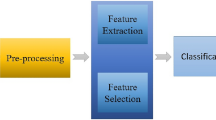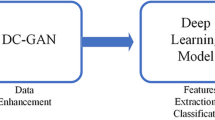Abstract
Face expression recognition has been proved as a challenging task in image processing. Many related works on facial expression recognition had done but they faced several challenges during the classification of data with the stored database. It carried out various workflows on improvisation of classifiers based on deep learning but they have been lagging in understanding facial expression mainly because of disastrous forgetting, time management, data mixing, and data overfitting, etc. Ignoring all these challenges would lead to inaccurate recognition of facial expressions. Hence to overcome all the above issues this work proposed a model named adaptive increasing-margin adversarial neural iterative model involves triple threat filtration techniques along with modified scaling density-based spatial clustering of applications with noise and dual feature model for obtaining a better quality featured image. Advance back propagation artificial neural network model is initiated to overcome catastrophic forgetting, underfitting of data, over fitting of data, etc. Thus, the proposed work achieves better efficiency as well as high accuracy in terms of facial expression recognition.






















Similar content being viewed by others
Explore related subjects
Discover the latest articles, news and stories from top researchers in related subjects.References
Aljundi R, Babiloni F, Elhoseiny M, Rohrbach M, Tuytelaars T (2017) Memory aware synapses: learning what (not)to forget 2017. arXiv preprint ArXiv: 1711.09601
Bah SM, Ming F (2020) An improved face recognition algorithm and its application in the attendance management system. Array 5:100014
Bi Y, Yuan K, Xiao W, Wu J, Shi C, Xia J, Chu G, Zhang G, Zhou G (2016) A local pre-processing method for near-infrared spectra, combined with spectral segmentation and standard normal variate transformation. Analyticachimicaacta 909:30–40
Cai J, Meng Z, Khan AS, Li Z, O'Reilly J, Tong Y (2019) Identity-free facial expression recognition using the conditional generative adversarial network. arXiv preprint arXiv:1903.08051
Gao T, Wang GY (2020) Brain signal classification based on deep CNN. Int J Secur Privacy Pervas Comp 12(2):17–29
Gopalakrishnan K (2018) Deep learning in data-driven pavement image analysis and automated distress detection: a review. Data 3(3):28
Hecht-Nielsen R (1992) Theory of the back propagation neural network. Neural networks for perception. Academic Press, Cambridge, pp 65–93
Kim Y, Yoo B, Kwak Y, Choi C, Kim J (2017) Deep generative-contrastive networks for facial expression recognition. arXiv preprint arXiv:1703.07140
Kirkpatrick J, Pascanu R, Rabinowitz N, Veness J, Desjardins G, Rusu AA, Milan K, Quan J, Ramalho T, Grabska-Barwinska A, Hassabis D (2017) Overcoming catastrophic forgetting in neural networks. Proc Natl Acad Sci 114(13):3521–3526
Lalitha SD, Thyagharajan KK (2020) Micro-facial expression recognition based on deep-rooted learning algorithm. arXiv preprint arXiv:2009.05778
Li S, Deng W (2020) Deep facial expression recognition: a survey. IEEE Transact Affect Comput
Liu P, Liu X, Yan J, Shao J (2018) Localization guided learning for pedestrian attribute recognition. arXiv preprint arXiv:1808.09102
Liu Y, Pu H, Sun DW (2017) Hyperspectral imaging technique for evaluating food quality and safety during various processes: a review of recent applications. Trends Food Sci Technol 69:25–35
Li Z, Hoiem D (2017) Learning without forgetting. IEEE Trans Pattern Anal Mach Intell
Lu X, Ma C, Ni B, Yang X, Reid I, Yang MH (2018) Deep regression tracking with shrinkage loss. In: Proceedings of the European conference on computer vision (ECCV), pp 353–369
Lu X, Wang W, Ma C, Shen J, Shao L, Porikli F (2019) See more, know more: unsupervised video object segmentation with co-attention siamese networks. In: Proceedings of the IEEE conference on computer vision and pattern recognition, pp 3623–3632
Lu X, Wang W, Shen J, Tai YW, Crandall DJ, Hoi SC (2020) Learning video object segmentation from unlabeled videos. In: Proceedings of the IEEE/CVF conference on computer vision and pattern recognition, pp 8960–8970
Maciel JM, Rodríguez FJC, González MM, Lecona FGP, Ramírez VMD (2017) Digital processing techniques for fringe analysis. Opt Interferomet 1
Mane S, Shah G (2019) Facial recognition, expression recognition, and gender identification. In: Data management, analytics, and innovation, pp 275–290
Pham TTD, Kim S, Lu Y, Jung SW, Won CS (2019) Facial action units-based image retrieval for facial expression recognition. IEEE Access 7:5200–5207
Serra J, Suris D, Miron M, Karatzoglou A (2018) Overcoming catastrophic forgetting with hard attention to the task. arXiv preprint arXiv:1801.01423
Timchenko LI, Pavlov SV, Kokryatskaya NI, Poplavska AA, Kobylyanska IM, Burdenyuk II, Wójcik W, Uvaysova S, Orazbekov Z, Kashaganova G (2017) Bio-inspired approach to multistage image processing. Photon Appl Astron Commun Ind High Energy Phys Exp 10445:104453M
Wong WK, Lai Z, Wen J, Fang X, Lu Y (2017) Low-rank embedding for robust image feature extraction. IEEE Trans Image Process 26(6):2905–2917
Wang Y, Luo X, Ding L, Hu S (2018) Visual tracking via robust multi-task multi-feature joint sparse representation. Multimed Tools Appl 77(23):31447–31467
Wu BF, Lin CH (2018) Adaptive feature mapping for customizing deep learning-based facial expression recognition model. IEEE Access 6:12451–12461
Zhang C, Wang P, Chen K, Kämäräinen JK (2017) Identity-aware convolutional neural networks for facial expression recognition. J Syst Eng Electron 28(4):784–792
Zeng N, Zhang H, Song B, Liu W, Li Y, Abdullah Dobaie M (2018) Facial expression recognition via learning deep sparse autoencoders. Neurocomputing 273:643–649
Zhao X, Shi X, Zhang S (2015) Facial expression recognition via deep learning. IETE Tech Rev 32(5):347–355
Zenke F, Poole B, Ganguli S (2017) Continual learning through synaptic intelligence. ArXiv preprint arXiv: 1703.04200
Khan K, Attique M, Khan RU, Syed I, Chung TS (2020) A multi-task framework for facial attributesclassification through end-to-end face parsing and deep convolutional neural networks. Sensors 20(2):328
Author information
Authors and Affiliations
Corresponding author
Additional information
Publisher's Note
Springer Nature remains neutral with regard to jurisdictional claims in published maps and institutional affiliations.
Rights and permissions
About this article
Cite this article
Vedantham, R. Adaptive increasing-margin adversarial neural iterative system based on facial expression recognition feature models. Multimed Tools Appl 81, 3793–3830 (2022). https://doi.org/10.1007/s11042-021-11320-1
Received:
Revised:
Accepted:
Published:
Issue Date:
DOI: https://doi.org/10.1007/s11042-021-11320-1




